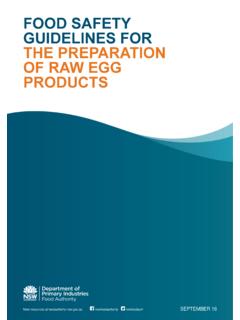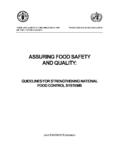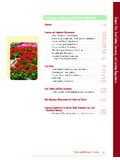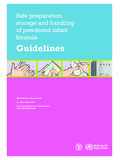Transcription of Guidelines for Food Safety on Merchant Ships and …
1 1 Guidelines for food Safety on Merchant Ships and Fishing Vessels International Committee on Seafarer s Welfare2nd Floor, Forsyth House77 Clarendon RoadWatford - Hertfordshire, WD17 1 DSUnited Safety is a basic requirement in the prevention of food related problems on board Ships . The sourcing of wholesome, safe food and water is clean and well maintained catering spaces give a good impression, food Safety is more than cleanliness. It requires good working practices in accordance with basic principles of personal hygiene and food hygiene, covering the separation of raw and cooked foods and temperature control for example. All vessels should apply food Safety principles. Even if not required by international regulations, documented systems with records enable a quality management approach to be taken, along the lines of the International Safety Management Code.
2 As well as helping to focus minds on food Safety , the system also provides evidence of good practices. On a small coaster vessels and other vessels where the number of crew refl ects an average family, a less formal system may and inspection of all elements in the food chain by the master or his deputy are a requirement in many countries. Although the catering department of a ship is responsible, everybody participates in the food Safety culture on board. Therefore everybody needs information and training on aspects of food Safety . These Guidelines are a good basis for training courses on health care and hygiene in all maritime training for food Safety on Merchant Ships and Fishing Vessels Content 1 Introduction 2 Receiving provisions 3 Stock Control 4 Deep Freezers 5 Cold Stores 6 Dry Stores 7 Bacterial Contamination 8 Personal Hygiene 9 Fitness to Work 10 Separate raw and cooked food !
3 11 Cleaning and disinfection 12 Buff ets 13 Leftovers1PA R T2 International Committee on Seafarer s WelfareDeep FreezersTemperature in freezers should be maintained at -18 C at least, but some tolerance levels should be allowed to take account of equipment. It is unlikely that short periods of -15 C will affect the quality and Safety of frozen food . Regular maintenance has to include checks on door seals, isolation of the doors, defrosting and checks on the correct functioning of time you enter the freezer room, the holding temperature is affected. Organise requirements to ensure access is kept to a minimum. Always close the door immediately on exit. Do not put food on the deck, use grids.
4 Never put food in the direct line of the cooling unit fan as this restricts air circulation and can lead to freezer ProvisionsIt is important to use reputable suppliers but basic control measures should be taken before storing supplies to check if the food is fi t for consumption, with a suitable shelf life compatible with the vessel s trading pattern. Since stores are often delivered Free Alongside Ship , this control has to take place before storing them on board. A simple check list should be used covering expiry dates, condition of the packages, and temperatures of chilled and frozen goods. Do not accept damaged packages or rusted tins. Chilled goods with a temperature above 7 C have to be refused.
5 Some goods like egg products (4 c), minced meat (2 c), and fresh fi sh (0-2 c) have to be delivered at a specifi c temperature that should be checked. The temperature of frozen goods should be -18 c or less. Ice crystals on frozen packages suggest improper storing arrangements prior to ControlShips should have adequate storerooms including dry and cold storerooms and freezers. If storing capacity is limited, stock should be reduced and stores taken more frequent-ly. food should not be stored on in a way that commodities are used in strict date rotation (First in = First out). Especially perishable food should not be ordered nor accepted in quantities that cannot be consumed before the expiry date.
6 Frozen foods maintained in hard frozen condition may be consumed beyond the date in Storerooms Avoid the use of meat hooks Wear gloves, Safety shoes and warm clothes in the deep freezer Defrost the deep freezer before cleaning it3 Guidelines for food Safety on Merchant Ships and Fishing Vessels Cold StoresKeep temperatures constant so far as possible to avoid humidity: 5 C is recommended, although a tolerance of up to 8 C is separate fridge should be used if possible for raw food . All items should be individually wrapped or covered. If raw and cooked foods are contained in the same cabinet, then raw food should be stored at the bottom to avoid contami-nating the cooked fruit and vegetables have different temperature requirements it is generally accepted that cool rooms or cabinets up to 10 C provide a satisfactory alternative.
7 Proper Storage Techniques for Fresh ProducePromptly put away fresh fruits and vegetables that need refrigeration. The following are the different condition requirements for keeping fresh fruits and vegetables at their optimum freshness : Only in the Refrigerator, Never at Room Temperature to Avoid Spoilage: apples, artichokes, asparagus, beans, beets, blueberries, broccoli, brussel sprouts, cab-bage, Belgian endive, carrots, caulifl ower, celery, cherries, sweet corn, cranberries, cucumbers, eggplant, ginger root, grapes, fresh herbs, leeks, lettuce and other greens, mushrooms, green onions, parsnips, peas, peppers, pineapple, new potatoes, radishes, raspberries, rhubarb, strawberries, squash, citrus fruit, turnips.
8 At Room Temperature until Ripe and then in the Refrigerator: apricots, avocados, kiwifruit, mangoes, melons, nectarines, papaya, peaches, pears, plums, tomatoes. Only at Room Temperature and preferably not in the Refrigerator: bananas, garlic, globe onions, mature potatoes, pumpkins, rutabagas, sweet fruit and vegetables well ventilated and stored in suitable boxes or containers. Plastic bags should be discarded as this material does not generally allow for proper ventilation, causing sweating to occur. Inspect every day and remove spoiled items, leaves Committee on Seafarer s WelfareDry StoresUse a register to keep track of dry stores. Check for the presence of pests or vermin. Check fl our and rice for the presence of insects.
9 Remove blown stores should be cool, around 10 C, dry, well lit and not put stores directly on the deck and not against the walls. Clean the dry store regularly and remove waste ContaminationFood poisoning bacteria are found on people, insects, rodents, refuse and waste food , even dust ; but thorough cooking will destroy most harmful bacteria will multiply rapidly if food is incorrectly prepared and stored. Even if it is correctly prepared or stored it can be cross-contaminated from raw food by using the same utensils for risk products, frequently associated with food poisoning should be carefully stored and protected from contamination. These products are generally high protein, ready to eat foods including cooked meats, poultry and raw or cooked fi sh, gravy and stock, milk, cream and eggs and any associated by-product.
10 food should be covered to prevent cross-contamination. Main reasons for food poisoning are : 1 Undercooking - Ensure that food is thoroughly cooked ! - juices from poultry and joints of meat should run clear !2 Unsafe temperatures to keep prepared Preparation of food to far in advance and stored at room Cooling food too slowly before Unsafe temperature in refrigerator and Bad way to keep food in the refrigerator : uncovered raw food , raw food together with or above prepared dishes. 7 Unsafe temperature to keep hot food (below 63 Celsius).8 Bad personal Dirty counters, cutting boards, knifes and small Dirty dishes and Infected food handlers with infectious diseases, wounds, ulcers or Defrost at room temperature or in warm Bad control and hygiene on pests and vermin.




